The university has also made good effort for publicity and providing a prize money (Rs 100,000 to 500,000) as an incentive for the winners.
Not to follow how the solar races happen elsewhere in the world, but to set our own standards which other International colleges would want to meet?
What are our universities teaching these students to solve? Or are the students just going through the paces!!?
Or are we just creating students that will work in 'Automobile Factories' albeit in better or probably managerial positions?
Would our engineers ever create something of their own? Or even how will the vehicles perform in a crash?
The University or the student doesn’t preserve any data online of their vehicle other than the spec. There is no data available for the outsider on how each vehicle performs. Example - top speed or range etc. They have many other handling tests which we believe are rather secondary. The main goal of an electric vehicle is always speed and range, next is their USE-ABILITY IN REAL WORLD and the rest hardly matters. Another thing I found very sad is that the students have about 5 or 6 pics about the vehicle they build and probably no video. It is obvious they are not consumed or moved or interested by the project they are building. Perhaps they are too busy with the task at hand. But for heaven’s sake this might be the only vehicle they might build in their entire lifetime. Get the data on record and at least 100 pics and 10 in-depth videos of the goddamn thing before it gets dismantled!
A good example of describing the vehicle is shown here by the students.
Marketing is that ability to push/showcase/project your product. Even though you have ability and idea it still requires that extra marketing ability to showcase the product. The best example being the coolest cooler which got kickstarted.
Videos and Pics are great to tools to publicize your products/works especially in the social media infested world, this would have been 10,000 times hard say 10 yrs ago.
On example is the way the experiments are promoted using youtube videos.
On the left below is LPU video and on the right is university of Michigan video. See the difference, unlike the LPU’s video the University of Michigan video stands apart. We are talking about just the video we will not get into the vehicles.
Both the Students and the University should have their own youtube channel where the students can upload their everyday adventure of building their vehicle. Next year's students could learn from this and even better the quality. Else everybody would keep making the same mistakes. This will teach them how to market/promote/advertise their vehicle. These videos will also act as advertisement for the University if they are well made. So instead of the University taking effort to create server space and upload videos the students can themselves take the advantage of sites like YouTube to upload their own videos and promote it and people can be encouraged to vote and on the final day the most "liked" video could also be given a prize.
|
|
|
Do the Indian Engineering students believe in their vehicle at all? Or do the students just build the vehicle for the sake of competition? Do they think that they or anyone else will be able to use this vehicle every day? If no, why not? So why can they not build something that people can use? One that will be safe and within the motor laws of the country? Something they will be able to sell in the market. Now building such a vehicle is called INNOVATION. Not building some crude vehicle to win some challenge? Why would any venture capitalist fund any vehicle that looks worse, cost more and carry lesser people than the Chinese e-rickshaws? The students should be learning to build vehicles that will sell rather than just building a random vehicle to win the competition but which will be of no use outside the arena.
Chetan Maini is the only person in India who went on to create and sell electric cars… not only in India but also the world when electric cars were not cool. He did it because he believed that it is possible. 1 person in 1 billion!
Ather Energy is another group that were successful in getting venture funding, which is because they believed. But what if they had not got funding? Most of the incubation period is 2 years but what if no funding came their way? With the kind of vehicles most students build they wouldn’t get any funding in the first place. But what about their belief in their ability to build and sell a vehicle or at least to use it in real life?
One student asked me “Is there any future for such vehicles?”. Doesn’t the student know? If he didn’t believe then why did he waste his time in building it. In the presentation he must have said that this vehicle and fuel is the future of automobiles. No?
Students should be encouraged to take the next step forward of that step of building a product that is sell-able.
The future has only 2 ways either bootstrap or go find a venture capitalist.
Bootstrap or Venture Cap?
If you have an idea the best way to give it away is to find a venture capitalist. Bootstrapping means using your shoestring budget to develop and sell your product. This could take a long time in the initial years maybe during the development the entire product could undergo metamorphosis and turn into something different.
Bootstrapping vehicle manufacturing would seem like a daunting task and expensive. But ways should be found to keep the cost low. Thus Building a 50K vehicle limit would be much better than a 100k vehicle. Crowd funding could be experimented within the college premises itself. Its easy to market anything today with social media. The students have a much higher advantage over many established companies in such aspect.
VC's are people who usually invest to make profit on their investment. The best thing about VC's are they are willing to give you the money. The worst thing with VC's want their money back. This could put immense pressure especially if the product is not selling. If they see that their investment is under threat they could remove you from the company. With VCs' you take money promising them a profit after a certain stage and once the stage is passed you are in for a lot of pressure and trouble. With a VC you might even be arm twisted into making decisions you wouldn’t have taken otherwise. Most of the time you and your co-founder would have the same vision and understanding of the market but the venture capitalist would not be tuned into your frequency and since most business in its infancy deals with intuition it would be very difficult to convince a venture capitalist about your view. This is especially true in electric vehicles where a petrol car can go up to 1000 kms on a full tank while an electric car can only reach 120 kms at full charge. It’s very difficult to convince that EV's can be better than Petrol car. The VCs might think development of a car is more the demand than development of a bike, or they might think the development of a faster car (80 to 100 kmph) would be the need of the hour than development of a slower car (25 to 30 kmph).
Did i just say a 30 kmph CAR? Some VC just took out a gun to shoot us as did some readers.
But you could drive a 30 kmph car on the road without requiring registration or license (DRIVING LICENSE would be a great help though) just like a bullock-cart doesn't. But if you develop a faster vehicle you can just keep it in your garage without being able to take it out on the road. Selling Pepsi is not the same as selling Apple Computers as John Sculley realized and with electric vehicles are exactly like that. Its not the same as selling petrol cars, the principles that work there doesn't work here.
But the advantage of VC's are that you get good visibility and publicity. The big investment ensure you have enough money for advertising and hiring the best in the business. But still with this publicity & advertisement you are unable to reach targeted sales figures within the 1st year then the going might enter turbulent waters.
So if you are one such engineering student who will be competing in electric vehicle competitions or if you an engineering faculty who will be inspecting or judging such a competitions keep in mind that YOU ARE ONE OF THE KEY
on how “Make In India” unfolds. The government might or might not give 101 incentives but if you cannot USE/SELL what you make whether In India or anywhere in the world, then you have to revise and upgrade your standards.
So let it be written… so let it be done…


